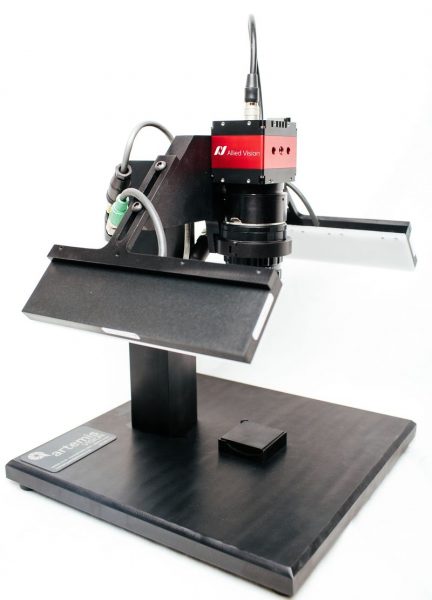Artemis Vision develops the new visionStation™ for precise and cost-efficient inspections of small parts

Photo by Allied Vision Technologies GmbH
Small parts manufacturers must find ways to complete inspections in a precise and cost-efficient manner.
Challenges of Small Parts Inspection
In the realm of inspecting small parts, there are existing challenges that must be overcome.
- Space constraints: Some small parts manufacturers have limited space for inspection equipment. When the main components of an inspection system are considered such as, the digital machine vision camera, lens, light source and processing unit, the size of a complete system can vary greatly. It becomes essential to understand the manufacturer’s needs and space requirements.
- Accuracy and repeatability: Inspecting small parts by eyesight alone can be a daunting task. Fatigue can set in after some time and can increase the likelihood of operator errors and missed defects. Furthermore, maintaining a consistent method or process of inspection (receiving, placing/loading, inspection and removal of the part) can change from person to person.
- Recognizing/cataloging defects: for any part inspection to be successful, the manufacturer must know what defects they are looking for. While some defects are obvious to the naked eye, others may be so miniscule that they go unnoticed. It becomes extremely important for a manufacturer to catalog all known defects. However, this catalog can be extensive depending on the part produced. A human inspector would have to check against the catalog to ensure the part is without defects, which can be a time-consuming and costly process.
Challenge Accepted by Artemis Vision’s visionStation™
Artemis Vision is the creator of the visionStation™, a standalone small-part vision inspection station capable of inspecting small parts. Artemis Vision is a machine-vision solution provider that delivers solutions using industry leading hardware and software engineering to optimize processes. The visionStation™ is precision machined from aluminum and fitted with a digital machine vision camera and lighting that is tailored to suit the type of inspection performed. It is an operator-loaded unit that can be used as a standalone inspection station or integrated into an existing operation. “The visionStation™ is ideal for customers who need to run approximately 20,000 parts per day or less,” states Tom Brennan, President at Artemis Vision. He continues, “At 3 seconds per cycle, an operator can load about 10,000 parts per shift. Customers who need flexible automation and repeatability between operators and production batches without necessarily wanting or needing full inline automation where parts are conveyed on a belt.”
The visionStation™ is offered in two sizes, the small and larger system measuring 1 and 1.5 cubic feet, respectively. The small system can accommodate parts up to 2 inches (5.08 centimeters), while the large system can hold parts up to 6 inches (15.24 centimeters). The minimum defect size allowance for each system size is: 0.003 inches (76.2 micrometers) for the small station and 0.01 inches (254 micrometers) for the larger station.
The visionStation™ utilizes Microscan’s Visionscape and Artermis Vision’s proprietary visionWrangler™ software. “Our software is built from our extensive library of components – reading a data matrix, doing measurements, absence-presence and counts,” explaines Brennan. visionWrangler™ provides 100% product inspection, tracking and reporting for stand-alone production systems, or as part of a global network. Also, it can collect and store data and images from inspections for later use.
To further ensure precise inspection, Artemis Vision builds a visionStation™ system based on the parts a manufacturer supplies and intends to have inspected. Once the specific requirements have been determined, the system is built, tested for ergonomics and ease of use. This tailored approach allows manufacturers to quickly setup the system and gain the peace-of-mind that their inspection needs are being met accurately.
Allied Vision Provides Camera Solution
Artemis Vision selected Allied Vision’s Prosilica GT4905 digital machine vision camera to capture images of the parts inspected. Equipped with the OnSemi KAI-16050 TRUESENSE CCD sensor, the Prosilica GT4905 delivers 16 Megapixels at 7.5 frames per second through a Gigabit Ethernet (GigE) interface. “We selected the Prosilica GT4905 because of its high resolution and excellent dynamic range,” explained Brennan. He continues, “The dynamic range plays an important part when imaging the shiny areas of a part, created by the lighting source. Furthermore, the Prosilica GT4905 can handle the rigorous conditions the visionStation™ may be used in.” The Prosilica GT4905 is designed to operate in tough environments with its rugged camera design and offers numerous features such as camera temperature monitoring, Trigger over Ethernet (ToE), and Power over Ethernet (PoE).
Future Development
As Artemis Vision looks to the future, small part inspection becomes increasingly important as the miniaturization of goods continues. Sensor technologies are also continuing to advance which further improves imaging capabilities. Artemis Vision plans to embrace these technologies in the next generation visionStation™. “We will likely upgrade to a newer CMOS camera and use C-mount optics,” Brennan comments, “which will provide more lensing options and reduce the overall size of the unit.”
For more information, please visit http://www.alliedvisiontec.com.
News Categories
- » NEWS HOME
- » Automation & Robotics
- » Industry 4.0
- » Material Handling
- » Sensors
- » Quality & Testing
- » Machine Vision
- » Laser & Optics
- » Metalworking
- » Motion Control & Drives
- » Hydraulics & Pneumatics
- » Process Industry
- » Renewable Energy
- » Agriculture
- » Home & Office Furniture
- » Environmental Tech









